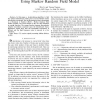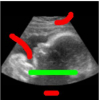107
Voted
ECCV
2010
Springer
15 years 5 months ago
2010
Springer
Abstract. Computer vision algorithms for individual tasks such as object recognition, detection and segmentation have shown impressive results in the recent past. The next challeng...
85
Voted
ICPR
2010
IEEE
15 years 6 months ago
2010
IEEE
Conventional contour tracking algorithms with level set often use generative models to construct the energy function. For tracking through cluttered and noisy background, however,...
71
Voted
ICIP
2006
IEEE
15 years 6 months ago
2006
IEEE
— In this paper, a de-interlacing algorithm to find the optimal deinterlaced results given accuracy-limited motion information is proposed. The de-interlacing process is formula...
ACIVS
2007
Springer
15 years 6 months ago
2007
Springer
This paper presents a new method to both track and segment objects in videos. It includes predictions and observations inside an energy function that is minimized with graph cuts. ...
66
Voted
ICMCS
2007
IEEE
15 years 7 months ago
2007
IEEE
We propose a new DCT-based energy function EDCT for objectoriented segmentation and compression. By minimizing EDCT the best possible split of the image blocks can be found which ...
121
Voted
CEC
2009
IEEE
15 years 7 months ago
2009
IEEE
— Automatic protein structure predictors use the notion of energy to guide the search towards good candidate structures. The energy functions used by the state-of-the-art predict...
89
Voted
ICPR
2010
IEEE
15 years 7 months ago
2010
IEEE
GMM based algorithms have become the de facto standard for background subtraction in video sequences, mainly because of their ability to track multiple background distributions, w...
104
Voted
ICIP
2002
IEEE
16 years 2 months ago
2002
IEEE
This paper presents a new object-based segmentation technique which exploits a large temporal context in order to get coherent and robust segmentation results. The segmentation pr...
117
click to vote
CVPR
2008
IEEE
16 years 2 months ago
2008
IEEE
We propose a scheme to introduce directionality in the Random Walker algorithm for image segmentation. In particular, we extend the optimization framework of this algorithm to com...
112
click to vote
CVPR
2008
IEEE
16 years 2 months ago
2008
IEEE
In this paper, we present novel techniques that improve the computational and memory efficiency of algorithms for solving multi-label energy functions arising from discrete MRFs o...


